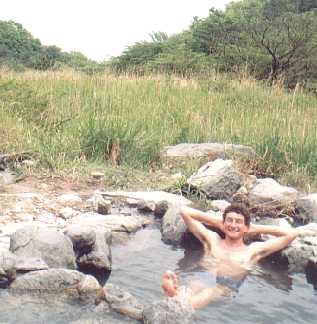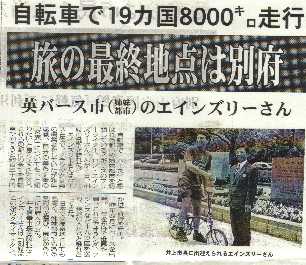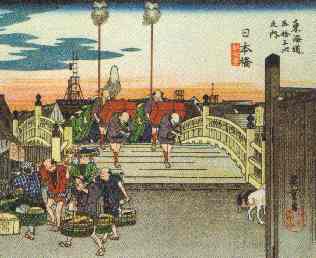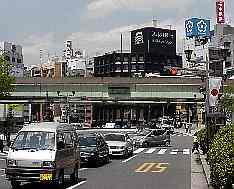 |
Diary: Beppu, Japan I arrived in Beppu on Monday 8 May, having cycled (most of the way...) from Tokyo. And what a great place! A lovely combination of hot springs and beautiful mountain scenery (see the wild hot pools of Nabeyama, above), of zippy tourist facilities, and secluded little hideaways. For four days the council and townspeople of Beppu treated me like a VIP, with guided tours of the spas, wonderful food, and great entertainment.
 Beppu can boast a superb new Conference Centre, B-Con, which includes a symphony hall and a tower that gives stunning views of the city, the marina, the parks and greenery. There's also a spiffy new university, the Ritsumeikan Asia Pacific, whose mountain-top panoramas are reminiscent of those from Bath's hilltop university. But Beppu is mainly associated in Japan for its onsen and jigoku. Onsen are natural hot springs for bathing in; jigoku - literally, 'hells' - are natural hot springs for looking at. Why you can't bathe in the jigoku becomes obvious when you see them. Some are bubbling mud pools that can boil eggs. Others are brightly coloured mineral-stained pools (red, blue, white, clear) that steam and hiss evilly. They would turn you the same colours if you were daft enough to jump in. The onsen are a different story. Thanks to Chika Sato, from Beppu Council, I managed to wallow in the hot spring waters of Ichinoide Onsen, a hillside open-air bright blue pool with views down to the city; in the natural, wilderness pools and gorgeously muddy streams of Nabeyama, up in the mountains; even in a beachside sand bath, where lady assistants bury you up to the neck and bake you gently for ten minutes! I had a meeting with the Mayor of Beppu, Nobuyuki Inoue - recorded by the local papers in the picture at the top (he's the one on the right, by the way). When Inoue-san learned that I had never eaten fugu - a Japanese fish delicacy - I was instantly whisked off in the mayoral limousine to enjoy an outstanding five-course lunch of fugu in the company of Mr Inoue himself. Anyone who knows Japanese food can tell you that this is something very special - many thanks indeed. (If you don't prepare fugu correctly, it's poisonous, and we mean lethal. Kids, don't try making fugu sushi at home.) I stayed at the home of Michio and Hisayo Sato (no relation to Chika, by the way) whose delicious food, friendliness and warm generosity I will always remember. I'm going to miss that sushi when I get back to England... They also took me out to a 1960s and 1970s music club called Hit Parade, where a Japanese Elvis and Doris Day, backed by the Hit Paraders, played some sensationally good music - impossible to resist dancing to! Many thanks to everyone I met from Beppu - I will miss you and take away some very fond memories of Bath's intriguing and vibrant twin town.
I got to do some canoeing in Shikoku, too, on the Shimantogawa river, said to be the last undammed, naturally flowing river in Japan. Thanks to the Yamamoto family who put me up and fed me superbly.
 Before Shikoku I was in Ise, visiting old friends Haruko and Mitsuru. They have a pottery gallery, 'Bien', which has an exhibition of superb pieces hand-picked by the very best of Mie's local artists, and which you should visit immediately and buy lots of items. It's a minute's walk from Ise-shi Kintetsu station. Despite my appalling English teaching to them 15 years ago, their English is still miles better than my Japanese. They have two children, Kazuma who is ten, and Chiharu who is only six, but her Japanese is still miles better than my Japanese.
Nihonbashi looked like this in the 1830s, though with stronger colours than the JPEG image can come up with, when Ando Hiroshige cut his famous series of woodblock prints on the 'Tokaido', the road between Tokyo and Kyoto:
 ...and this is what it looks like now:
 The Tokaido was once the major route in Japan. In Hakone, a national park west of Tokyo, a few km of the old road survives. I passed through it on the way, cycled along the old route, and enjoyed some superb views of a snow-capped Fuji.
|
 And as for the Brompton, this remarkable folding bicycle proved to the ideal choice for bike touring in Japan. Trains, buses, cable cars, hitchhiking - no problem! And it proved capable of tackling distance too - en route to Beppu I did up to 90k a day in the rural and scenic island of Shikoku no problem, the only proviso being that you HAVE to travel light (no more than a day pack) and you avoid any steep hills (which means following river valleys and railway lines, both of which are plentiful in Japan). But then, those are sensible rules for bike touring anyway! With those points in mind, I'd highly recommend Brompton touring to anyone.
And as for the Brompton, this remarkable folding bicycle proved to the ideal choice for bike touring in Japan. Trains, buses, cable cars, hitchhiking - no problem! And it proved capable of tackling distance too - en route to Beppu I did up to 90k a day in the rural and scenic island of Shikoku no problem, the only proviso being that you HAVE to travel light (no more than a day pack) and you avoid any steep hills (which means following river valleys and railway lines, both of which are plentiful in Japan). But then, those are sensible rules for bike touring anyway! With those points in mind, I'd highly recommend Brompton touring to anyone. I set off from Nihonbashi, Tokyo on 22 April, after exploring some of the hot baths and cool bars with friends Rog and Rie (pictured) who live over here.
I set off from Nihonbashi, Tokyo on 22 April, after exploring some of the hot baths and cool bars with friends Rog and Rie (pictured) who live over here.  The Brompton was kindly loaned by the company via Mizutani Cycles of Tokyo.
The Brompton was kindly loaned by the company via Mizutani Cycles of Tokyo.